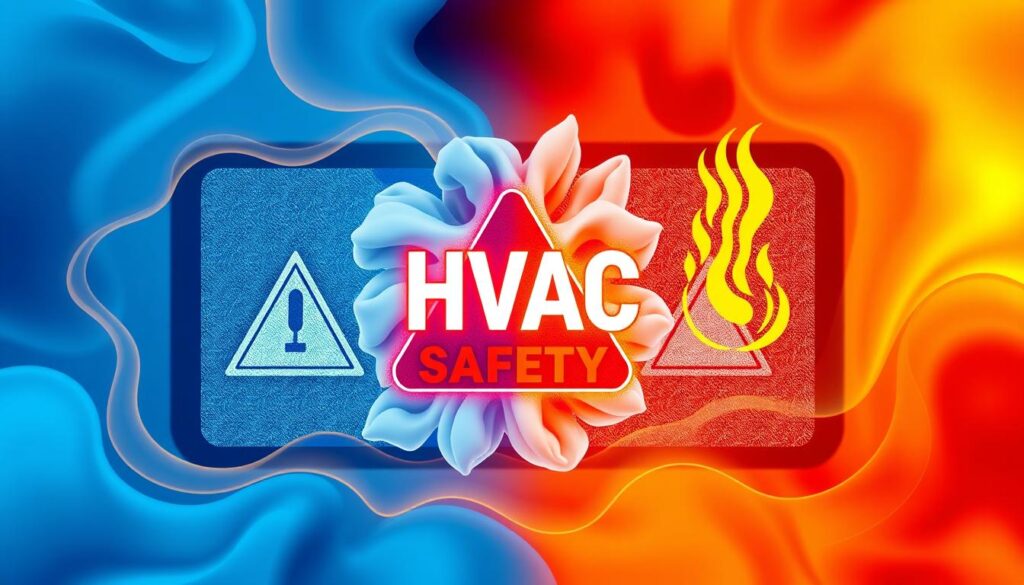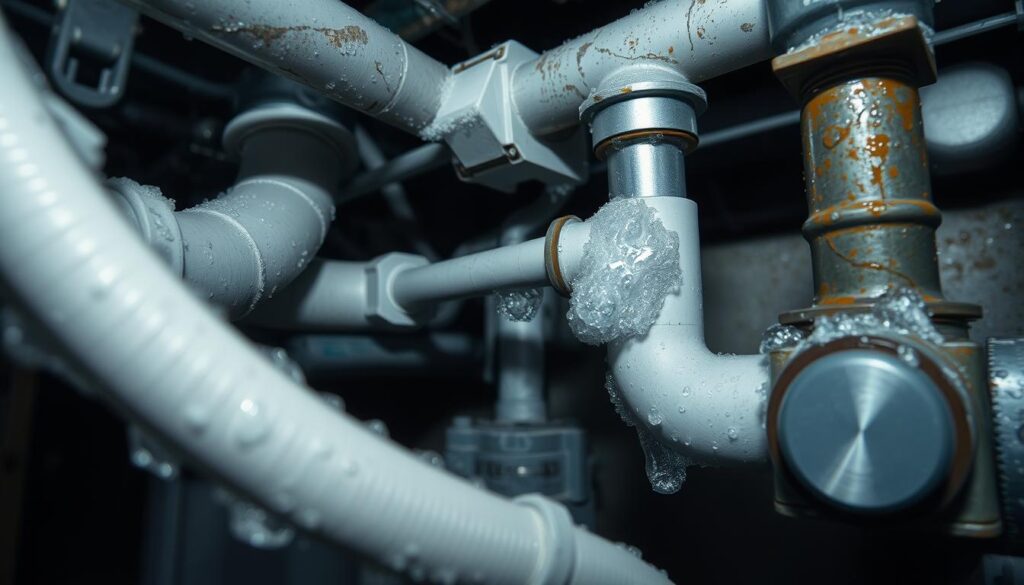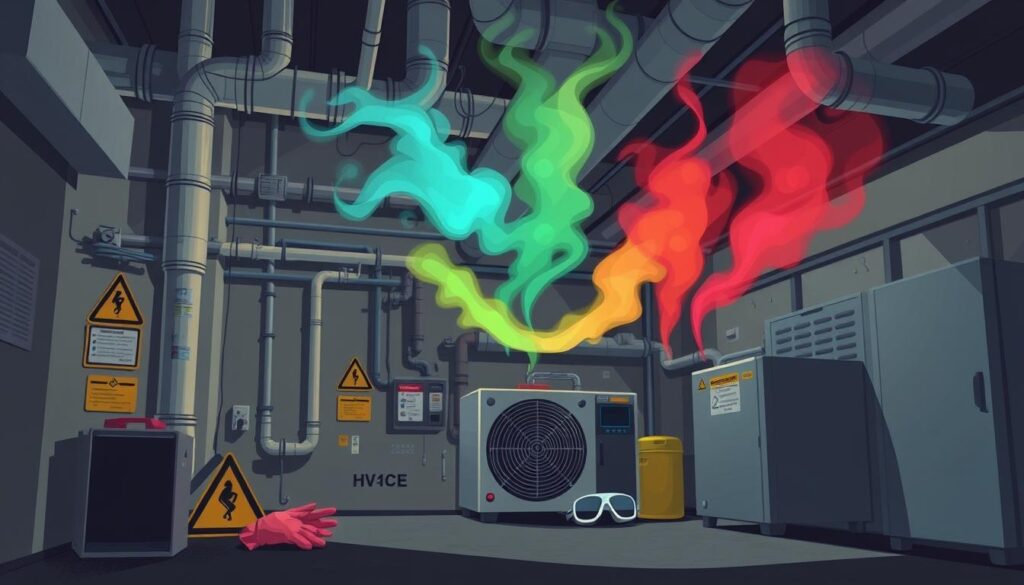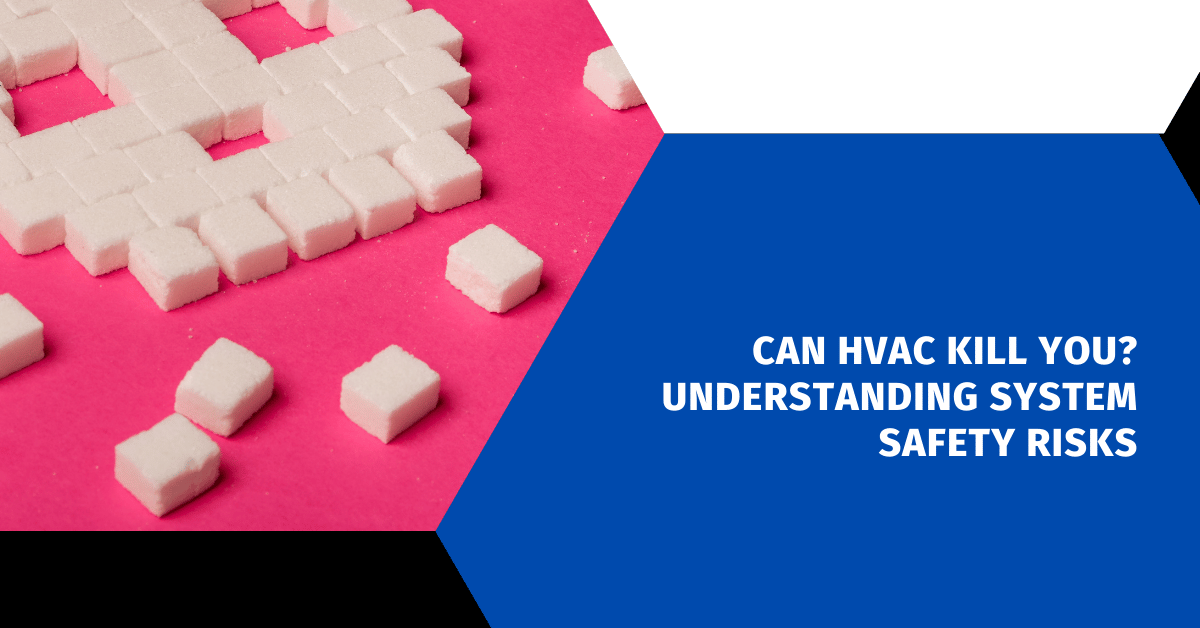Affiliate Disclosure
HVAC Guide Guys is a participant in the Amazon Services LLC Associates Program, an affiliate advertising program designed to provide a means for sites to earn advertising fees by advertising and linking to Amazon.
Can HVAC Kill You? When you think about your home’s heating, ventilation, and air conditioning (HVAC) system, safety might not be the first thing you think of. These systems are meant to keep us comfortable and healthy. But, HVAC systems can be dangerous if not installed, maintained, and used correctly. So, can HVAC kill you? The answer might surprise you.

HVAC systems are complex and need special care. They can have many safety risks, like electrical dangers and suffocation. In this article, we’ll look at the dangers of HVAC systems. We’ll also talk about how to keep your home and family safe.
Key Takeaways
- HVAC systems can pose serious safety risks, including potential fatalities.
- Common HVAC hazards include falls, electric shocks, chemical exposure, and suffocation.
- Between 2010 and 2015, the US Department of Labor reported 38 HVAC technician fatalities due to harmful substance exposure or environments.
- Proper training, safety equipment, and awareness are crucial for preventing HVAC-related accidents and deaths.
- Regular HVAC maintenance and professional servicing can help mitigate safety risks.
Table of Contents
Understanding the Hidden Dangers of HVAC Systems
HVAC systems are key to keeping our homes comfortable and air clean. But, they also hide dangers that need to be known and fixed. Issues like carbon monoxide poisoning and refrigerant leaks can be very harmful if not handled right.
Common Safety Hazards in HVAC Operation
HVAC systems can be risky, with problems like overheating, dust buildup, and blocked airflow. These can cause fires, breathing issues, and even risk of not getting enough air. The National Fire Protection Association says one in six house fires starts with heating equipment, showing how crucial HVAC safety is.
Statistics on HVAC-Related Incidents
HVAC dangers are not just rare events. In fact, they happen more often than many think. The U.S. Consumer Product Safety Commission says over 20,000 people end up in the emergency room each year because of HVAC problems. This shows we need to be more aware and take safety steps seriously.
Risk Factors in Residential Settings
Home HVAC systems face special dangers because of tight spaces and often, not being well-kept. Bad ventilation, wrong installation, and ignoring upkeep can make these systems more dangerous. Homeowners must make sure their HVAC systems are well-looked after and used safely to avoid these risks.
“Proper maintenance and safety protocols are crucial in ensuring the safe operation of HVAC systems, as they can pose serious threats if neglected.”
Explore Our HVAC Shop
Looking for top-rated HVAC tools, parts, and accessories? Visit our shop and find the perfect solution for your needs.
Visit the ShopCan HVAC Kill You? The Truth About System Safety
HVAC systems can be dangerous if not maintained or used correctly. They can cause asphyxiation or poisoning from gases like carbon monoxide. It’s important for both HVAC experts and homeowners to know these risks.
Carbon monoxide poisoning is a big risk with HVAC systems. Around 50,000 people visit emergency departments every year because of carbon monoxide poisoning (CDC), and over 400 people die annually due to this silent killer (CDC). If the system is faulty or not installed right, this colorless, odorless gas can build up indoors. This can cause serious health problems and even death.
Refrigerant leaks are also dangerous. Freon and other refrigerants can be deadly if inhaled. Even a small amount can cause fluid buildup in the lungs, breathing issues, organ damage, and sudden death. Handling these chemicals wrong can risk the lives of both technicians and homeowners.
Another risk is air displacement, which can cause asphyxiation. 10 people fell ill with COVID-19 after dining at an air-conditioned restaurant in Guangzhou, China between January 26 and February 10, 2020, due to airborne transmission facilitated by the HVAC system (CDC). Poor ventilation can make the air too low in oxygen, leading to serious or fatal outcomes.
To avoid these HVAC safety risks, regular maintenance and proper ventilation are key. Homeowners should get annual check-ups from professional HVAC technicians. Trying to fix things yourself can be very dangerous.
Knowing the truth about HVAC safety and taking action can keep these systems safe and reliable. It’s crucial for both HVAC experts and homeowners to stay alert and informed. This way, we can prevent HVAC fatalities and keep everyone safe.
Explore Our HVAC Shop
Looking for top-rated HVAC tools, parts, and accessories? Visit our shop and find the perfect solution for your needs.
Visit the ShopCarbon Monoxide: The Silent HVAC Killer
Carbon monoxide (CO) is a deadly, odorless gas that can come from broken HVAC systems. It’s a “silent killer” that can sneak up on you without warning. In the US, about 50,000 people end up in the emergency room each year from CO poisoning. Sadly, nearly 500 of them don’t make it.
Signs of Carbon Monoxide Poisoning
The signs of CO poisoning can be tricky to spot. They might feel like the flu. You might feel a dull headache, dizzy, weak, nauseous, or vomit. If it gets worse, you could have trouble breathing, get confused, or even pass out.
Being around too much CO gas can cause serious problems. This includes brain damage, heart issues, and even death.
Prevention and Detection Methods
- Put carbon monoxide detectors on every floor of your home, at least 15 feet from any burning appliances.
- Check CO detectors every month and change the batteries once a year.
- Get your HVAC system checked every year to make sure it’s working right and venting properly.
- Only use appliances that are UL-listed and make sure your home has enough air.
Emergency Response Protocols
If a CO alarm goes off, act fast. Get everyone out of the building, call the fire department, and count everyone to make sure they’re all there. Turn off any heating or appliances and open windows and doors to let air in.
Get medical help for anyone showing CO poisoning symptoms. Call a skilled HVAC expert to fix the problem before you go back inside.
Knowing about carbon monoxide and how to prevent it can keep your family and home safe from this silent killer.
Refrigerant Leaks and Their Deadly Consequences
Refrigerant leaks in HVAC systems are a serious health risk. They can cause refrigerant poisoning, which is very dangerous. R-22, or Freon, is a heavy gas that can replace oxygen in small spaces. This can lead to asphyxiation and even death.
The Institute of Refrigeration reported five fatalities caused by refrigerant asphyxiation in 2011. Inhaling R-22 dangers can cause headaches, dizziness, nausea, and skin irritation. Long-term exposure can lead to fluid buildup in the lungs, irregular heartbeat, seizures, and loss of consciousness.
It’s important to keep your HVAC system well-maintained and watch for signs of leaks. Hissing sounds, reduced cooling, and frozen coils are signs of a leak. If you think there’s a leak, get everyone out, turn off the system, and call a professional.

Working with HVAC refrigerants requires careful handling and ventilation. Regular maintenance can catch and fix leaks before they’re dangerous. By staying informed and proactive, you can keep your HVAC system safe and protect your family from refrigerant leaks.
Explore Our HVAC Shop
Looking for top-rated HVAC tools, parts, and accessories? Visit our shop and find the perfect solution for your needs.
Visit the ShopAir Displacement and Asphyxiation Risks
HVAC systems can hide air displacement dangers, especially in tight spaces. Gases like nitrogen, used for pressure tests, can quickly replace oxygen. This is a deadly risk of asphyxiation. It’s key to know about these hidden dangers to keep HVAC workers, homeowners, and others safe.
How Gases Displace Oxygen
Nitrogen, about 78% of our air, can be very dangerous in small spaces. When nitrogen levels go up, oxygen levels drop fast. This creates a space where it’s hard to breathe, leading to asphyxiation quickly.
This danger is sneaky because it’s hard to see the oxygen drop. It happens fast, leaving little time to act before serious problems start.
Warning Signs of Oxygen Depletion
- Dizziness
- Headache
- Difficulty breathing
- Confusion and disorientation
The US Chemical Safety and Hazard Investigation Board says about eight people die each year from nitrogen asphyxiation. Ten percent of these victims are rescuers who didn’t see the danger. Spotting early signs of oxygen loss is key to avoiding these tragedies and keeping everyone safe around HVAC systems.
“Nitrogen under high pressure can pose risks when the pressure is released, potentially leading to accidents such as blow-ups of regulators and tanks.”
For HVAC pros and homeowners, knowing about HVAC asphyxiation risks, oxygen displacement, and HVAC gas hazards is crucial. By watching for signs of oxygen loss and taking safety steps, we can stop these terrible accidents. This helps keep everyone safe around HVAC equipment.
Chemical Exposure Hazards in HVAC Systems
As an HVAC professional, you might face a hidden danger in the systems you work on. This danger is toxic chemical exposure. You could be exposed to harmful substances like phosgene gas and peracetic acid, which can harm your health. It’s crucial to know about these hazards to stay safe and protect your team.
Phosgene gas can cause serious breathing problems if you breathe it in. In 2011, a California incident showed how dangerous peracetic acid can be. It hospitalized many HVAC workers. It’s important to have the right training, wear protective gear, and know about chemical dangers.
- HVAC technicians have one of the highest injury rates of any profession according to the Bureau of Labor Statistics.
- Roughly 1,000 deaths annually are caused by injuries from electrical hazards in HVAC systems, accounting for 5% of burn ward admissions.
- Asbestos inhalation by HVAC workers in buildings built before the 1970s can potentially lead to lung cancer.
To fight HVAC chemical exposure and toxic gas risks, you need to be careful and take action. Knowing the HVAC poisoning dangers and following safety rules can keep you and your colleagues safe.

Being well-informed and prepared is key to avoiding the dangers of HVAC work. With the right knowledge and precautions, you can keep yourself and your team safe. This ensures a safe work environment for everyone.
Explore Our HVAC Shop
Looking for top-rated HVAC tools, parts, and accessories? Visit our shop and find the perfect solution for your needs.
Visit the ShopCritical Safety Measures for HVAC Operation
Keeping HVAC systems safe is key. It’s important to have good ventilation and use the right safety gear and rules. This helps lower the risks of working with HVAC.
Proper Ventilation Requirements
Good air flow is vital, especially when working with refrigerants or in tight spaces. The Minimum Efficiency Reporting Value (MERV) shows how well filters catch small particles. For example, isolation rooms need special filters to keep air clean.
Places like operating rooms need to change the air at least 15 times an hour, as the CDC suggests. This helps keep the air fresh and clean.
Safety Equipment and Protocols
HVAC techs need the right safety gear. This includes masks, gas detectors, and more. They also need clear rules for handling chemicals and what to do in emergencies. Following these steps can greatly reduce the chance of accidents.
It’s also important to place HVAC units in the right spots. They should not be too loud or shake a lot, especially over rooms where patients are being treated. Having extra HVAC units ready is a smart move, too. This way, if one breaks down, others can take over.
By following these safety steps, HVAC experts can make sure systems work well and safely. This creates a safe place for everyone.
| Safety Aspect | Recommendation |
|---|---|
| Ventilation Requirements |
|
| Safety Equipment and Protocols |
|
| HVAC System Placement |
|
“Proper safety measures are crucial in HVAC operations to ensure the well-being of workers and occupants.”
Professional Maintenance vs DIY: Safety Implications
Choosing between professional maintenance and DIY repairs for your HVAC system is crucial. Saving money by doing it yourself might seem appealing. But, the risks of doing it wrong can be very serious.
HVAC experts get a lot of HVAC safety training. They have the right tools and know-how to spot and fix hazards. They handle refrigerants safely and check for carbon monoxide leaks. They also make sure the air is well-ventilated, which is important for safety.
On the other hand, DIY HVAC risks are real. Without the right skills and tools, you could face dangers like asphyxiation or chemical exposure. Even simple tasks like duct cleaning can release harmful particles into the air, causing breathing problems.
Getting regular HVAC professional maintenance is key to keeping your system safe and working well. Experts can find and fix problems early, saving you from big costs and dangers later. Regular checks and tune-ups can prevent major issues and keep your family safe.
Even though professional maintenance costs more upfront, it’s worth it. It ensures your family’s safety and keeps your HVAC system running smoothly for years. Choosing expert care is a smart investment for your home and your health.
Explore Our HVAC Shop
Looking for top-rated HVAC tools, parts, and accessories? Visit our shop and find the perfect solution for your needs.
Visit the ShopEmergency Response to HVAC Hazards
When HVAC emergencies happen, quick action is key. It could mean the difference between life and death. If you think there’s a gas leak, chemical exposure, or other dangers, act fast and follow HVAC emergency steps.
If you spot a possible HVAC hazard, get out of the area right away. Turn off the system, open windows and doors for air, and call for help. Don’t try to check it yourself, as it could be risky.
- Watch for warning signs: Look out for strange smells, hissing sounds, or any HVAC system issues that might be dangerous.
- Evacuate and isolate: If you think there’s a gas leak or chemical spill, leave the building and keep the area away from others.
- Shut off the HVAC system: Switch off the HVAC unit at the main power source to stop any further problems.
- Call for professional help: Call 911 or an HVAC expert who can handle the emergency.
- Follow emergency protocols: Listen to what emergency responders or HVAC pros tell you to do to stay safe.
Quick action and following HVAC safety rules can reduce the risk of harm in emergencies. Knowing the dangers and being ready to act can keep you and your family safe from HVAC risks.
| Emergency Procedure | Description |
|---|---|
| Evacuate and Isolate | Immediately leave the affected area and prevent others from entering, to contain the hazard and prevent further exposure. |
| Shut Off HVAC System | Turn off the HVAC unit at the circuit breaker or main power source to stop the flow of gas, chemicals, or other hazardous substances. |
| Call for Professional Help | Dial 911 or contact a qualified HVAC technician who can properly assess and address the emergency situation. |
| Follow Emergency Protocols | Comply with the instructions provided by emergency responders or HVAC professionals to ensure your safety and the safety of others. |
Your safety is the most important thing in HVAC emergencies. Stay alert, act fast, and follow safety rules to avoid tragic outcomes. This way, you can keep yourself and your loved ones safe from HVAC dangers.
Prevention Strategies and Best Practices
Keeping your HVAC system safe and efficient is key. Regular HVAC maintenance schedules and HVAC safety inspections help a lot. They reduce HVAC risk prevention and protect your home or workplace.
Regular Maintenance Schedules
Make a detailed maintenance plan for your HVAC system. It should include checks for leaks, ventilation, and efficiency. Following the manufacturer’s guidelines and industry standards is vital for safe and consistent operation.
Safety Inspection Checklists
A detailed safety inspection is vital for HVAC risk prevention. Your checklist should cover electrical parts, gas connections, and refrigerant levels. This helps spot and fix safety issues early on.
It’s also important to train your HVAC team well. They should know safety rules, how to use PPE, and the latest best practices. Following safety standards and manufacturer guidelines is a must.
“Preventive maintenance is the best way to avoid costly HVAC system breakdowns and ensure the safety of your occupants. Regular inspections and proactive maintenance can go a long way in safeguarding your investment and protecting your loved ones.”
With good HVAC maintenance schedules and HVAC safety inspections, you can lower HVAC risk prevention. This keeps your HVAC system safe and efficient for many years.
Conclusion
HVAC systems are key to keeping our homes comfortable and safe. But, they can be dangerous if not taken care of right. Knowing the risks, like carbon monoxide poisoning and refrigerant leaks, helps us stay safe.
Regular maintenance and following safety rules are crucial. Fixing issues like closed vents or clogged filters also helps. This way, your HVAC system lasts longer and works better.
Putting HVAC safety awareness, HVAC risk management, and HVAC system protection first is important. This reduces the risk of serious HVAC problems.
Stay informed and watch out for potential dangers. Rely on certified HVAC pros for help. Your safety and that of your family should always come first.

